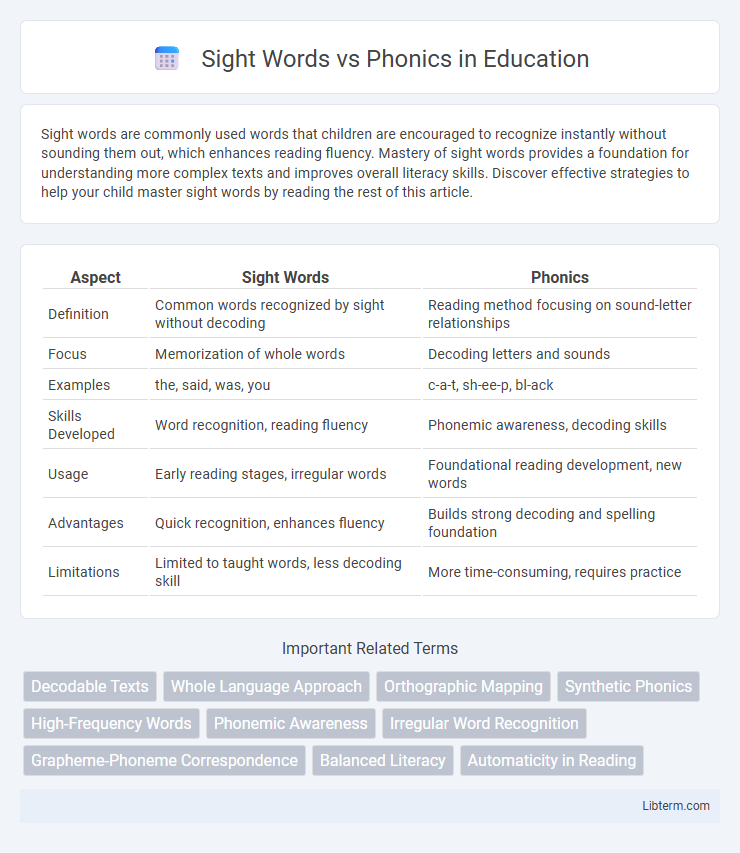Sight words are commonly used words that children are encouraged to recognize instantly without sounding them out, which enhances reading fluency. Mastery of sight words provides a foundation for understanding more complex texts and improves overall literacy skills. Discover effective strategies to help your child master sight words by reading the rest of this article.
Table of Comparison
| Aspect | Sight Words | Phonics |
|---|---|---|
| Definition | Common words recognized by sight without decoding | Reading method focusing on sound-letter relationships |
| Focus | Memorization of whole words | Decoding letters and sounds |
| Examples | the, said, was, you | c-a-t, sh-ee-p, bl-ack |
| Skills Developed | Word recognition, reading fluency | Phonemic awareness, decoding skills |
| Usage | Early reading stages, irregular words | Foundational reading development, new words |
| Advantages | Quick recognition, enhances fluency | Builds strong decoding and spelling foundation |
| Limitations | Limited to taught words, less decoding skill | More time-consuming, requires practice |
Understanding Sight Words and Phonics
Sight words are high-frequency words recognized instantly without decoding, supporting fluent reading and comprehension. Phonics involves teaching the relationships between letters and sounds, enabling learners to decode unfamiliar words systematically. Combining sight word recognition with phonics instruction enhances reading proficiency by balancing memorization and decoding skills.
The Science Behind Sight Words
Sight words are recognized instantly without decoding, leveraging the brain's visual memory to enhance reading fluency and comprehension. Scientific studies emphasize that sight word recognition activates neural pathways distinct from phonological processing, highlighting the importance of direct word retrieval in early literacy development. Effective reading instruction combines sight word acquisition with phonics-based decoding to strengthen diverse cognitive mechanisms essential for proficient reading.
How Phonics Supports Reading Development
Phonics instruction supports reading development by teaching children the relationships between letters and sounds, enabling them to decode unfamiliar words independently. This method enhances phonemic awareness and builds foundational skills for fluent reading and spelling. Unlike sight words, which rely on memorization, phonics equips learners with systematic strategies to read and understand a wide range of texts.
Key Differences: Sight Words vs Phonics
Sight words are commonly used words recognized by memory without needing decoding, essential for reading fluency, while phonics involves understanding letter-sound relationships to decode unfamiliar words. Sight words often include irregular spelling patterns that defy phonetic rules, requiring memorization, whereas phonics emphasizes systematic instruction of sound-letter correspondences. Effective reading instruction balances sight word recognition and phonics skills to build comprehensive literacy development.
Advantages of Teaching Sight Words
Teaching sight words enhances reading fluency by enabling students to instantly recognize common words without decoding, which accelerates comprehension. Familiarity with sight words supports early reading development, especially for irregularly spelled words that phonics rules alone cannot address. Mastery of sight words builds confidence and motivation, encouraging young learners to engage more actively with texts.
Benefits of Phonics Instruction
Phonics instruction enhances reading proficiency by teaching the relationship between letters and sounds, enabling learners to decode unfamiliar words independently. It supports improved spelling skills and boosts reading fluency by reinforcing consistent sound-letter patterns. Research indicates that phonics-based learning leads to higher literacy rates and better comprehension compared to memorization of sight words alone.
Challenges in Using Sight Words and Phonics
Sight words often present challenges because they require memorization without phonetic cues, leading to difficulties in recognizing unfamiliar words within context. Phonics instruction can be complex, as learners struggle to apply consistent sound-letter rules due to irregularities in English spelling patterns. Balancing sight word recognition with phonics decoding remains a critical hurdle in developing fluent reading skills.
Integrating Sight Words and Phonics in Classrooms
Integrating sight words and phonics in classrooms enhances literacy development by combining whole-word recognition with decoding skills. Using phonics instruction to decode unfamiliar words complements sight word memorization, enabling students to read fluently and comprehend text effectively. This balanced approach leverages both visual memory and phonetic understanding, fostering stronger reading proficiency in early learners.
Choosing the Right Approach for Early Readers
Choosing the right approach for early readers involves understanding the benefits of both sight words and phonics instruction. Sight words support quick recognition of common vocabulary, enhancing reading fluency, while phonics builds foundational decoding skills by teaching the relationship between letters and sounds. Combining these methods tailored to individual learning styles maximizes reading development and comprehension in early education.
Best Practices for Balanced Literacy Instruction
Effective balanced literacy instruction integrates sight words and phonics to enhance reading fluency and comprehension. Sight words provide immediate recognition of high-frequency vocabulary, while phonics teaches decoding skills essential for unfamiliar words. Combining systematic phonics lessons with repetitive sight word exposure fosters robust literacy development and supports diverse learner needs.
Sight Words Infographic

 libterm.com
libterm.com